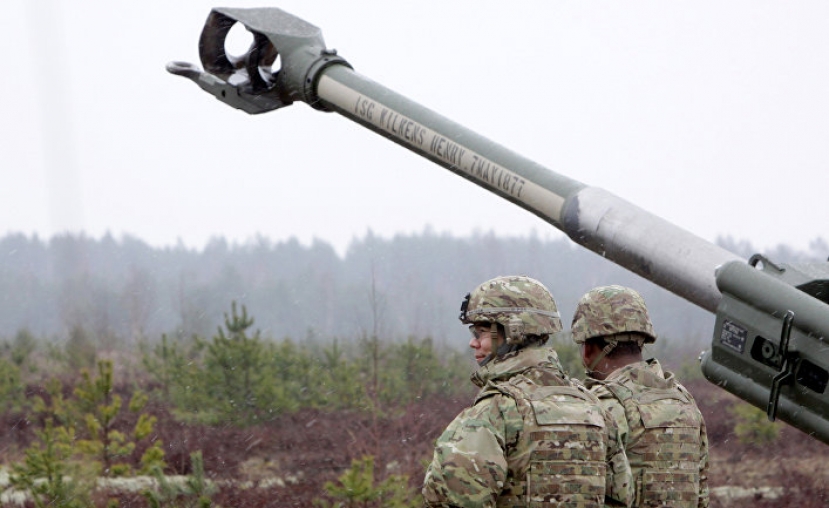NATO CATCHES ON TO PUTIN'S GAME IN EUROPE
17.07.2016 09:56
 NATO CATCHES ON TO PUTIN'S GAME IN EUROPE
NATO CATCHES ON TO PUTIN'S GAME IN EUROPE
NATO inflicted a major setback on Russian President Vladimir Putin at the Warsaw Summit on July 8 and 9. The Alliance agreed to deploy a total of eight battalions to Eastern Europe. Yet Moscow had been anticipating the pushback and was already working on countermeasures to diminish and offset it. But, barring major changes in the political leadership in key Western nations, the Kremlin’s moves will not seriously improve its geopolitical fortunes. The West’s new clarity of purpose should maintain pressure on Moscow for its continuing aggression in Ukraine.
Putin has made clear his national security goals. He wants a sphere of influence in the post-Soviet space; a new security architecture in Europe and Eurasia; and a weakened and divided NATO and EU, so that he can expand Russian influence into Europe.
Moscow cannot pursue its revisionist agenda in Europe directly, since it is much weaker in economic and military terms than the United States, NATO, and the EU. To establish its sphere of influence, Moscow has gone to war in Georgia and Ukraine, but it has done so carefully, selling the fictions that Georgian President Saakashvili started the first conflict and that Moscow is not at all involved in the second.
The Kremlin has tried to keep the West oblivious to its motivation. In Georgia, the Kremlin tried to sell the line—with some success—that it was an impetuous Georgian president who set off the war; and in Ukraine, Moscow maintains that it is not leading, financing, supplying, or providing soldiers for the fighting in the Donbass.
But Putin has a problem: the Alliance has caught on. The Warsaw Summit statement notes that “Russia’s provocative actions, including…its demonstrated willingness to attain political goals by the threat and use of force…fundamentally challenge the Alliance… and threaten the long term goal of a Europe whole, free and at peace.”
Warsaw demonstrated that NATO was finally focused on Kremlin aggression. In Warsaw, NATO and the EU agreed to increase intelligence and security cooperation. While Europe is still feeling the impact of the United Kingdom’s vote to leave the EU, Warsaw served to steady the continent.
Moscow’s problems do not end here. On July 1, the EU renewed sanctions on Russia. While NATO did not break any new ground at Warsaw in its relationship with Georgia or Ukraine, the Alliance, the U.S., and several other NATO states are providing substantial training and increasingly sophisticated military equipment to both nations.
NATO’s new measures have not persuaded the Kremlin hawks to revisit their revisionist goals; it has merely encouraged them adopt new tactics and to double down on some old ones. Ambassador Alexander Grushko, Moscow’s representative to NATO, claims that there is no justification for NATO’s new deployments; the government continues to maintain the threadbare fiction that Moscow is not responsible for the war in the Donbass.
This expands their ongoing effort to split the Alliance by playing to the Europeans for whom normal relations with Moscow are worth more than peace in Ukraine. German Foreign Minister Frank-Walter Steinmeier’s ill-considered statement that NATO deployments and exercises in the east are warmongering encourages Moscow to double down on efforts to split Europe. Moscow hopes to persuade the EU to ease sanctions next winter.
In addition, Moscow continues to take countermeasures. In Kaliningrad, which is west of the Baltic states, Moscow has deployed advanced S-400 anti-aircraft missiles, which gives them a substantial area access area denial (A2AD) capability that NATO must contend with when planning for possible Russian aggression. Moscow has also deployed three heavily armed combat brigades, one of naval infantry. Moscow also maintains the 7054 th Air Base there with a full complement of fighters, bombers, and helicopter gunships. Moscow has threatened to permanently deploy the nuclear-capable 9K720 Iskander-M ballistic missiles in Kaliningrad. In addition, Defense Minister Sergey Shoigu announced that Moscow was deploying three more divisions to the Western Military District, which borders the Baltic states, in response to NATO’s decision to deploy the four battalions in Poland and the Baltic states.
Senior people around Putin understand the damage that Russia’s war in the Donbass has inflicted on the country. But no serious reconsideration of its Ukraine policy can be expected until next year at the earliest. In the coming months, Moscow will rev up its efforts to see if its friends within the EU can get them sanctions relief in January. More important, Putin is hoping against hope that Donald Trump wins the U.S. presidential election. If Trump were to act on his statement that NATO is obsolete, the Kremlin can wait a year to have its way in Ukraine and beyond.
